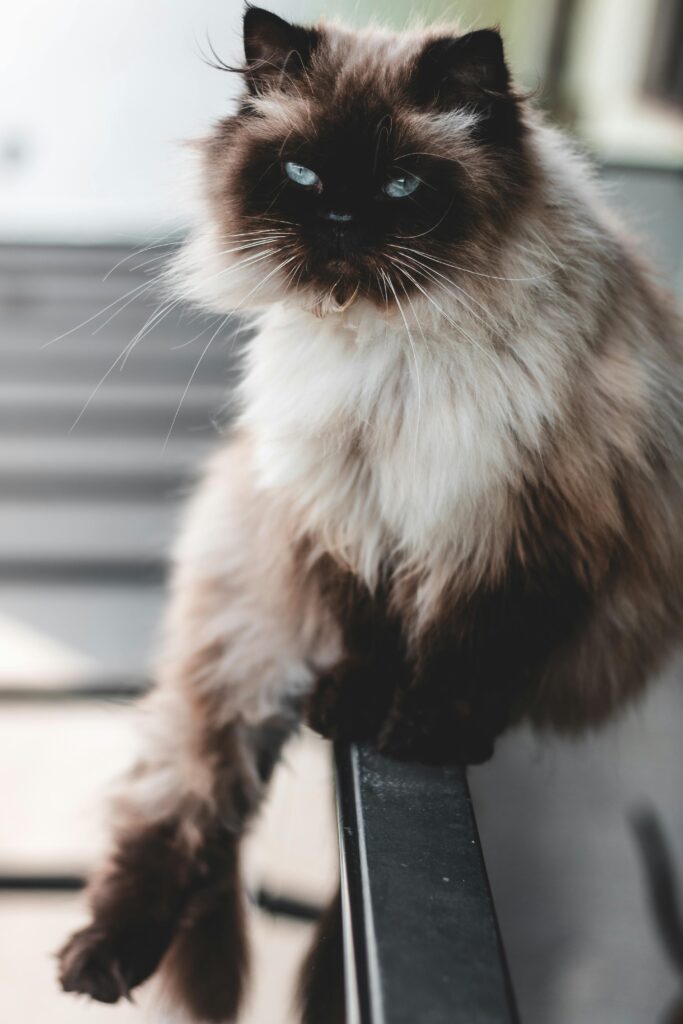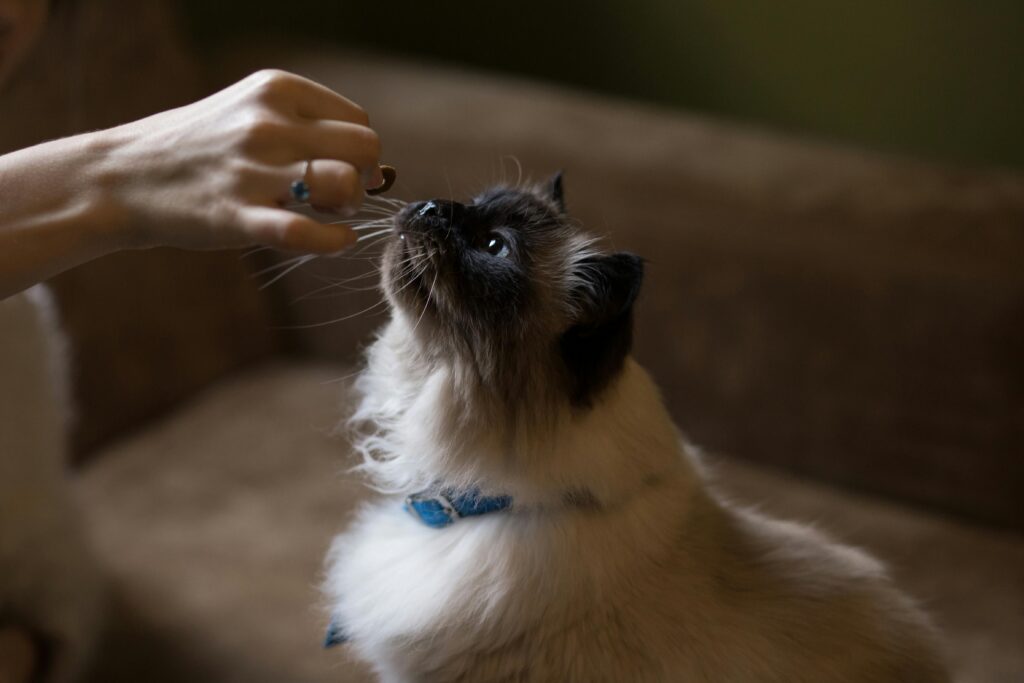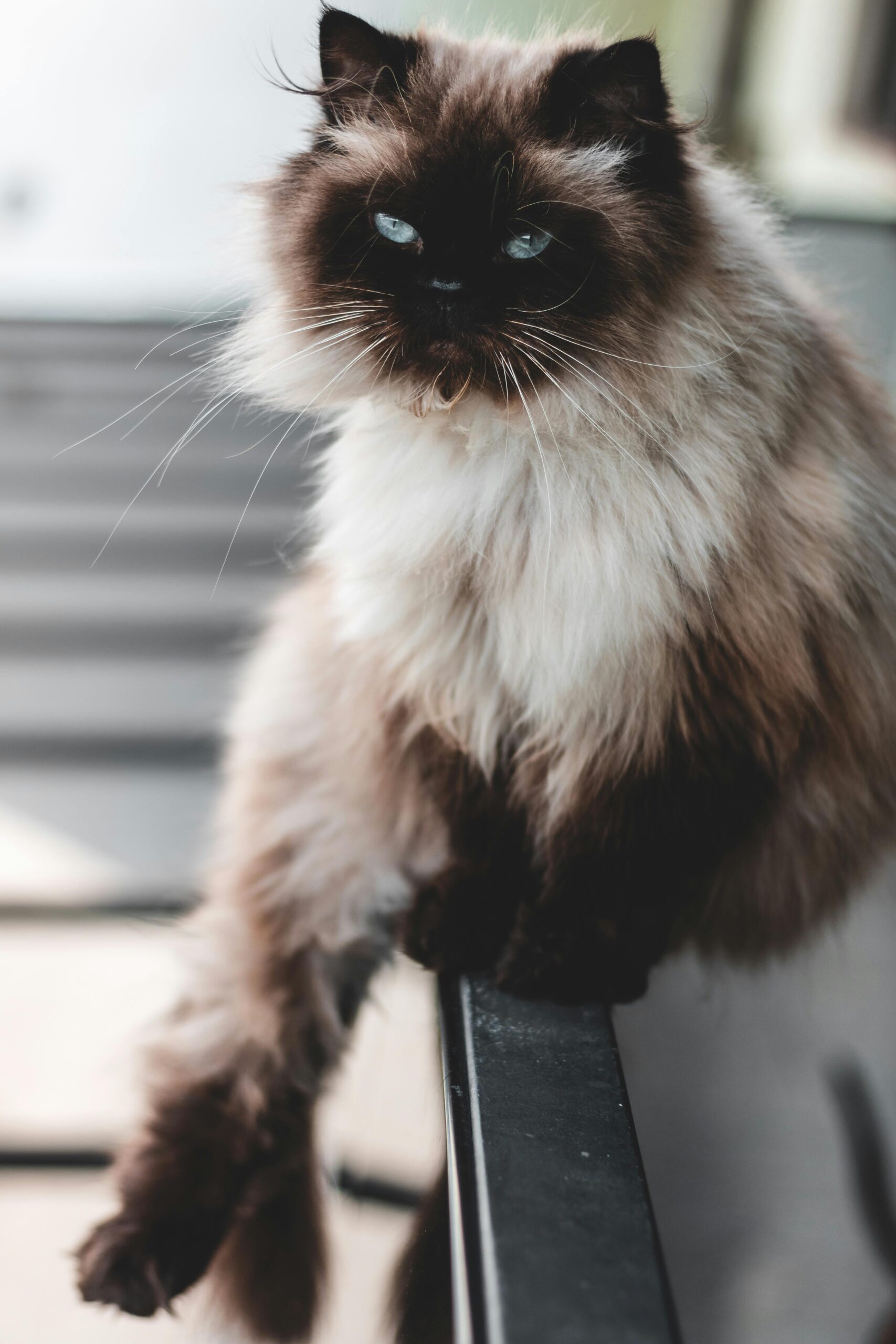
Himalayan cat breeder searches can be overwhelming, but finding the right Himalayan cat breeder is the key to bringing home a healthy, well-socialized kitten you’ll love for years.
If you’re researching Himalayan cats but are open to other luxury breeds, explore our beautiful Ragdolls and Available Kittens. Our kittens are raised with love, health testing, and early socialization so you can find your perfect soul cat.
The Top 10 Himalayan Cat Breeders in the USA (2025)
1. KaristaKats — New Jersey
KaristaKats has been breeding CFA-registered Himalayans since 2000. They focus on traditional “doll-face” Himalayans rather than the extreme flat-faced Persians. This cattery is known for maintaining healthy lines and offering kittens that retain the breed’s classic look with fewer health issues tied to extreme brachycephalic features.
2. Burnbrae Cattery — Maryland
Located in Maryland, Burnbrae is a small cattery dedicated to producing healthy Persian and Himalayan kittens. Registered with CFA, they focus on health, type, and temperament. They are selective in their breeding, producing only a small number of kittens each year, which means long waitlists but excellent individual care.
3. Gems of the South — Florida
Established in 2002, Gems of the South breeds Persian and Himalayan kittens. They operate under CFA guidelines and provide registration papers once kittens are altered. Their site is frequently updated with new kitten announcements, and they emphasize both health and early socialization for family life.
4. Central Coast Persians — California
Based in California’s central coast region, this CFA-registered cattery offers Persians and Himalayans raised in a home environment. They prioritize socialization and transparent communication with buyers. Known for producing sweet-tempered kittens, they appeal to families across the West Coast.
5. KingdomKatz — Midwest
KingdomKatz is a small CFA-registered show cattery breeding Himalayans and Persians. They emphasize type, health, and happiness, producing kittens that are well-adjusted for both show and companion homes. Their reputation in the show ring also signals their commitment to maintaining breed standards.
6. Rocky Mountain Persians — Colorado
This Colorado-based program breeds Persians, Himalayans, and Exotics. CFA-registered, they educate buyers on the registration process and prioritize health and conformation. Their Himalayan kittens are particularly well-regarded for their balanced features and loving personalities.
7. Beljapur Cattery — Texas
Beljapur breeds Persians and Himalayans with CFA registration. Their focus is on champion bloodlines, routine vaccinations, and raising kittens in the home environment. Families who adopt from Beljapur often praise their kittens’ friendly temperaments and beautiful coats.
8. Lilac Farms Cattery — Connecticut
Victorian Gardens is a CFA-registered cattery that breeds Persian and Himalayan kittens. They highlight PKD-negative DNA testing, HCM ultrasound checks, and other proactive health measures. They maintain a closed cattery for disease control and breed for health and temperament.
9. Berryhill Cattery — Pennsylvania
Berryhill is one of the longer-standing catteries, registered with CFA and TICA. Originally focused on Himalayans, they continue to breed and show in the Persian/Himalayan world. Their kittens are well-known in the Mid-Atlantic region and beyond.
10. Khloe’s Kittens — New Jersey
Khloe’s Kittens is a family-run program specializing in Persian, Himalayan, and Exotic Shorthairs. Conveniently located near NYC and Philadelphia, they are accessible for buyers in the Northeast. Their kittens are raised with hands-on care, making them well-socialized pets for busy households.
How We Selected the Breeders

When you search “Himalayan cat breeders” online, you’re immediately faced with dozens of options. Some look professional, others look questionable, and a few are outright scams. So how do you know who really deserves a spot on a Top 10 list? The truth is, not every breeder meets the standards that ensure a kitten will grow into a healthy, well-adjusted adult cat.
For this roundup, we used a set of strict criteria to decide which breeders to highlight. These standards aren’t just arbitrary; they reflect what matters most to buyers who want a Himalayan that will be part of their family for the next 12–18 years.
1. Verified Registry Memberships
Every breeder on this list is registered with at least one major cat registry — CFA (Cat Fanciers’ Association) or TICA (The International Cat Association). Why does this matter? Because registration shows the breeder is operating within recognized breed standards. CFA and TICA also require accurate record-keeping of pedigrees, which reduces the risk of fraudulent claims about lineage.
2. Commitment to Health Testing
Himalayans, like their Persian relatives, are prone to certain hereditary conditions. Polycystic Kidney Disease (PKD) is one of the most common, but breeders can easily test their cats with a simple DNA swab. Reputable breeders test all breeding cats and are transparent about results. We prioritized breeders who openly discuss PKD, FeLV/FIV, and general veterinary care.
3. Reputation & Longevity
Anyone can create a slick website overnight, but true credibility comes from years of consistent work in the breed. Breeders who have been active for a decade or more, or who have champion cats in CFA/TICA shows, demonstrate stability and dedication. We gave preference to catteries with a visible history rather than new or unverified programs.
4. Breeding Ethics & Kitten Rearing
Raising Himalayan kittens isn’t just about producing a pretty cat — it’s about socialization, care, and preparing them for family life. We favored breeders who raise kittens inside their homes or in carefully managed spaces, not in mass-production kennel environments. Early socialization, exposure to everyday sounds, and hands-on interaction make a huge difference in a kitten’s future temperament.
5. Transparency & Buyer Support
Finally, we looked at how breeders communicate with potential buyers.
- Do they provide contracts?
- Do they clearly explain their policies for deposits, spay/neuter, and health guarantees?
- Do they offer ongoing advice after the kitten goes home?
Transparency is one of the strongest signs of a breeder who cares about both their cats and their clients. These catteries aren’t identical but all of them meet the bar for ethics, health, and quality. Please do your own research before getting a kitten.
How to Choose the Right Himalayan Cat Breeder
Choosing a Himalayan breeder can feel overwhelming, especially when every website promises beautiful kittens and happy families. But the truth is, not all breeders are the same. Some operate as passionate preservationists of the breed, while others cut corners — skipping health testing, raising kittens in poor conditions, or even selling without proper registration. Taking the time to evaluate a breeder carefully can save you from years of heartache and unexpected costs.
Start with Registration and Reputation
The first thing to confirm is whether the breeder is registered with CFA (Cat Fanciers’ Association) or TICA (The International Cat Association). Registration shows that the breeder is accountable to recognized standards and that their cats are pedigreed. While registration alone isn’t proof of quality, it’s an important baseline.
Reputation is equally vital. Look for breeders with a track record — those who have been in the community for years, have shown cats, or have been recommended by other owners. Avoid catteries with no online presence, no testimonials, or suspiciously perfect reviews that read like marketing copy.
Ask About Health Testing
Himalayans are prone to Polycystic Kidney Disease (PKD), a hereditary condition that can shorten lifespan and lead to costly veterinary care. Ethical breeders will test their cats for PKD and share results. They should also test for FeLV/FIV and maintain routine veterinary care. If a breeder avoids questions about health or cannot provide proof, that’s a red flag.
Evaluate Socialization Practices
A Himalayan kitten’s temperament is shaped early. Kittens raised in the home, with exposure to sounds, people, and handling, are far more likely to grow into affectionate, adaptable adults. Ask breeders how they raise their kittens. If they are kept in cages or barns with minimal interaction, you may end up with a shy or fearful cat.
Understand Contracts and Policies
A reputable breeder will always provide a written contract. Look for key elements:
- Health guarantees covering genetic conditions.
- Spay/neuter agreements for pet-quality kittens.
- Clear refund or replacement policies in case of major health issues.
- Terms for when registration papers are released (often after proof of spay/neuter).
Avoid breeders who sell kittens without contracts or who seem unwilling to answer detailed questions about policies.
Communication and Support
The best breeders don’t disappear after you take your kitten home. They act as a lifelong resource, answering grooming questions, helping with diet choices, and celebrating milestones with you. Ask yourself: does this breeder feel approachable and supportive? Or are they rushing you to place a deposit without building trust?
Red Flags to Watch For
- Prices far below the market average.
- No verifiable registration with CFA or TICA.
- Refusal to send videos of kittens.
- Demands for wire transfers or unusual payment methods.
- Stock photos used instead of real kitten images.
By applying these filters, you’ll narrow your choices to breeders who genuinely care about the breed and the families they place kittens with.
Himalayan Cat Kitten Price Guide (2025)
One of the most important questions future Himalayan owners ask is: “How much does a Himalayan kitten cost?” The answer isn’t simple because prices vary by breeder reputation, quality, and location. To make things clearer, here’s a full breakdown of what you can expect in 2025 when shopping for a Himalayan kitten in the United States.
Average Price Ranges
Most Himalayan kittens from reputable, CFA- or TICA-registered breeders fall within the range of $1,500 to $4,000+. The wide spread reflects the kitten’s intended purpose: pet, show, or breeding.
- Pet-Quality Kittens: $1,500 – $2,500
These are kittens sold strictly as companions. They may have slight cosmetic differences (like imperfect markings or a less “show-ideal” face) but are still healthy, beautiful, and affectionate. They’re sold with spay/neuter contracts and registration papers released after proof of sterilization. - Show-Quality Kittens: $2,500 – $3,500+
These kittens meet the Himalayan breed standard closely — strong bone structure, striking blue eyes, excellent coat quality, and symmetrical points. Even if you don’t plan to show, many families choose show-quality kittens simply because of their striking looks and potential for awards. - Breeding-Quality Kittens: $3,500 – $4,500+
Only a small number of breeders sell kittens with breeding rights, and these are typically reserved for other established catteries. These kittens are priced at a premium because they influence the future of the breed and usually come from champion bloodlines.
Regional Price Differences
Where you live can also affect kitten prices.
- Northeast (NY, NJ, PA, MD): $2,000 – $3,500
High demand in metropolitan areas like New York City keeps prices steady. Breeders such as KaristaKats and Khloe’s Kittens operate in this region. - Southeast (FL, NC, GA): $1,800 – $3,200
More breeders are located here, creating slightly more competition and variation in pricing. Gems of the South (Florida) and Victorian Gardens (North Carolina) are key names. - Midwest (OH, IL, MI, IN): $2,000 – $3,000
KingdomKatz and other small show catteries maintain moderate pricing. - West Coast (CA, WA, OR): $2,200 – $3,800
California breeders like Central Coast Persians often charge at the higher end due to high demand and cost of living. - Southwest (TX, CO, AZ): $2,000 – $3,800
Breeders like Beljapur (Texas) and Rocky Mountain Persians (Colorado) set prices in this range, reflecting both quality and limited supply in the region.
Why Are Himalayans So Expensive?
Several factors drive the price of Himalayan kittens:
- Health Testing: Ethical breeders DNA test for PKD and screen for FeLV/FIV, which adds costs but ensures healthier cats.
- Veterinary Care: Kittens receive vaccinations, deworming, and sometimes microchipping before going home.
- Socialization & Time: Raising kittens in-home with constant attention requires effort and limits litter numbers.
- Coat & Grooming: Himalayans have high-maintenance coats that require daily care even from an early age. Breeders often begin grooming training, which takes time.
- Champion Bloodlines: Show-quality pedigrees carry a premium due to their rarity and influence on the breed’s future.
Budgeting Beyond the Kitten Price
It’s important to budget for ongoing care:
- Initial Supplies: Litter boxes, scratching posts, food bowls, carriers (~$200–$300).
- Grooming: Combs, brushes, detangling sprays, and professional grooming if needed (~$100–$400 annually).
- Veterinary Care: Annual check-ups, vaccinations, and emergency funds (~$400–$600 per year).
- Pet Insurance: Optional but recommended for this breed due to potential health issues (~$30–$50/month).
The Value of Luxury Kittens
While it might seem tempting to choose the cheapest option, investing in a Himalayan from a well-regarded breeder pays off in health, temperament, and support. Luxury kittens, like those raised in programs that emphasize socialization, health testing, and lifelong breeder support, often cost more upfront but save buyers from costly vet bills and behavior issues down the line.
Frequently Asked Questions About Himalayan Kittens
1. How much does a Himalayan kitten cost in 2025?
In 2025, Himalayan kittens from reputable breeders typically cost $1,500–$4,000+. Pet-quality kittens are on the lower end, while show-quality and breeding-quality kittens are priced higher. Regional demand also plays a role, with West Coast and Northeast kittens often being more expensive.
2. Are Himalayan cats good pets for families?
Yes. Himalayans are affectionate, gentle, and adaptable. They tend to bond closely with their families and enjoy quiet companionship. While they’re not as active as some breeds, they thrive in households that can give them daily grooming and attention. They do well with children and other pets when properly socialized.
3. Do Himalayan cats require a lot of grooming?
Absolutely. Himalayans have long, dense coats inherited from their Persian ancestry. Daily combing is recommended to prevent mats and tangles. Many owners also invest in grooming tools like slicker brushes, wide-tooth combs, and detangling sprays. Professional grooming every few months can also help maintain the coat’s health.
4. What health problems are common in Himalayan cats?
The most common hereditary issue is Polycystic Kidney Disease (PKD), which ethical breeders test for. They can also experience brachycephalic concerns (breathing issues tied to flat faces), eye tearing, and dental concerns. Regular veterinary check-ups, a quality diet, and choosing a PKD-tested kitten help reduce risks.
5. Are Himalayan cats hypoallergenic?
No. Himalayans are not hypoallergenic. Their long coats can trap dander and saliva proteins that cause allergic reactions. If you have allergies, spend time with Himalayans before committing to adoption, and consider investing in air purifiers and regular grooming to help manage allergens.
6. How long do Himalayan cats live?
Himalayan cats typically live 12–15 years, with some reaching 17 years or more when well cared for. Longevity depends on genetics, diet, preventive veterinary care, and a safe indoor lifestyle. Cats from breeders who perform health testing tend to live longer, healthier lives.
7. What is the difference between Persian and Himalayan cats?
The Himalayan is essentially a Persian with Siamese-style pointed coloring (darker ears, face, tail, and paws). They share the same body structure, luxurious coat, and calm temperament as Persians but are distinguished by their striking blue eyes and pointed patterns.
8. How can I tell if a Himalayan breeder is reputable?
Look for CFA or TICA registration, proof of PKD and FeLV/FIV testing, written contracts, and transparent communication. Reputable breeders will gladly answer questions, show you the kittens via live video, and explain their policies on spay/neuter and health guarantees.
9. What colors do Himalayan kittens come in?
Himalayans come in a variety of point colors, including seal, blue, chocolate, lilac, flame, cream, tortie, and lynx points. Seal and blue are the most common, while chocolate and lilac are rarer and often more expensive. The points develop as the kitten grows, with full color contrast visible by one year of age.
10. Where can I find Himalayan kittens for sale near me?
Start with CFA and TICA breeder directories, then look at established catteries such as KaristaKats (NJ), Gems of the South (FL), Victorian Gardens (NC), and Central Coast Persians (CA). Always research carefully, ask for health testing proof, and avoid deals that seem “too good to be true.”
For families seeking a luxury adoption experience, you can also explore available kittens at almontecats.com.
Still exploring your options? Dive deeper into our breed guides and resources:
- How Much Is a Ragdoll Kitten in 2025?
- How to Spot Cat and Kitten Scams Online
- Himalayan Cat Prices in 2025
- Are Ragdoll Cats Hypoallergenic?
- How to Reserve Your Almonte Kitten
Each post is packed with facts, tips, and advice to help you choose the perfect kitten for your family.





Read the Comments +